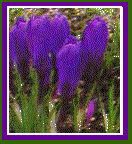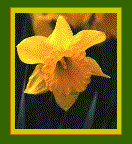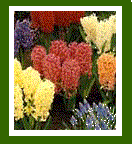




mail me! 
main page HELP 1. always purchase good quality bulbs. firm, large sized, with no signs of mold 2. plant deeper than normally recommended. 3. use a balanced bulb food in the spring and fall 4. let the foliage die back before removing 5. plant tulips deep and plant annuals or perennials over the top of them. This will help keep the bulbs cool in summer. 6. store unplanted bulbs in a cool, dry location. |
BULBSCrocus, when most think of the crocus they think of spring. Now there are some fall bloomers also! Get your fall crocus in the ground as soon as you can, they will bloom the first year. I planted my spring blooming crocus right in my lawn. They are small bulbs so you don't have to dig very deep and I placed the sod over them. By the time you need to mow next spring, they should be finished blooming and you can mow right over the top of them.
Tulips.......There are so many different colors, heights, shapes and varieties. It is a hard decision choosing tulips for me. I have 5 different beds I plant them in. This way I can take advantage of the different varities.
When planting tulips I recommend planting them eight inches deep, which is deeper than the tags say. This makes it easier for them to come back year after year. It is also important to add a bulb food in the bottom of the hole. Sprinkle the food and then put a layer of soil between it and the bulb. The point goes up.
Place the bulbs 6 to 8 inches apart, in good quality soil. Add humus if you need too, and some sand for drainage. A raised bed in full sun is an excellent location. A neat trick I learned while working in the nursery business was planting tulips in with peony roots. I couldn't resist some of the more exotic varieties. When I decided to purchase these, I bought a minimum of 5 each. These tulips were planted in clumps around an old stump in the yard.
Tulip bulbs have a tendency to look alike, when purchasing bulk tulips remember to use a different bag for each variety and tag each bag. If you can't plant right away, store them in a cool dry place. You can plant tulips as long as the ground isn't frozen.
Daffodils.......For naturalizing this is a perfect choice! Daffodils and Narcissi are a beautiful addition to a bulb garden. Daffodils are no longer in the basic yellow. You can buy these in white, pink, yellow and white mixtures, yellow and orange mixtures. Minatures are wonderful, growing to a height of 6 inches, these make a wonderful border plant. If you think the daffodil is too plain, check out the double blooms.
When you plant them around your tulips, they also protect the tulip bulbs from moles. Planting varies on the size of the bulb. Most minatures are planted at a depth of 3-4 inches. The larger bulbs are planted at 9 to 10 inches. As with all bulbs let the foliage mature before removing it. This is how the bulb replaces it's energy for the next years bloom.
From the trumpets, like King Alfred, to the double blooms of Cheerfulness and the minature blooms of tete a tete, there is a daffodil for everyone.
Hyacinths........Nothing smells quite as wondeful as a hyacinth. Plant these close to walkways and areas where you like to go often. Hyacinths are available in many different colors, white, pink, lavender, purples, blues, reds, yellow, and orange. You can make the most of your Hyacinths by watching the bloom times.
Plant Hyacinths in a humusy, well draining soil. Most prefer to be planted at least 6 inches deep. The first year, they have spectacular blooms. To maintain the blooms for years to come, add a good quality bulb food when planting and in the early spring. Keeping them in full sun will help keep them from becoming so tall they can't support their blooms.
This bulb is easily forced for indoors blooming. Some varieties are hybrids developed especially for forcing. They are pretty in groups of three or five and also alone in a hyacinth jar. Grape Hyacinths are a smaller flower. They are easily grown and bloom profusely.
INDOOR FORCING.....
Paperwhite narcissi and amaryllis are normally thought of when forcing bulbs. However, you can also force tulips, hyacinths, crocus, daffodils and most bulbs. Bulbs planted in September or early October are normally ready to bloom in January.
Purchase good sized bulbs in early fall. Prepare a container with a quality soil that drains well. You can plant one bulb in a 4 inch pot or you can plant a variety of bulbs in a larger container. Azalea pots make a good choice for a container. They are shorter than a regular flower pot. Fill the pot one-half to two-thirds full of soil. Add your bulbs, tulips should have the flat side towards the outside of the pot. Cover the bulbs with soil and water gently. When the excess water is drained store the pot in a cool spot. Temperatures should be between 32 and 45 degrees.
Check on your bulbs to be sure they don't dry out. (I prefer to let them get a little dry rather than overwatering). When top growth is seen bring the pot into a cool area of the house. Letting the bulbs adjust to the temperture change. After a few days put it in a sunny location, turning the pot occasionally to insure even growth. Two to four weeks later blooms should appear. If you decide to fertilize, use a bloom promoting food, rather than a houseplant food.
Paperwhites and Amaryllis are pre-cooled. You don't need to place them in a cool spot. Just plant according to directions. Amaryllis should have one-third to one-half of their bulbs above the soil level.
 last updated September 18, 1996 This page designed by Calla |